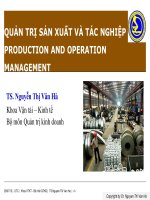Marcro micro econmiy david begg chapter 034
Bạn đang xem bản rút gọn của tài liệu. Xem và tải ngay bản đầy đủ của tài liệu tại đây (81.17 KB, 10 trang )
Chapter 34
The international monetary system
David Begg, Stanley Fischer and Rudiger Dornbusch, Economics,
6th Edition, McGraw-Hill, 2000
Power Point presentation by Peter Smith
Key issues
Exchange rate regimes and their
implications for the world economy
Possibilities of policy co-ordination
Policy co-ordination in Europe
34.2
Exchange rate regimes
Exchange rate
Fixed
Forex intervention
Floating
Free
float
Gold standard
currency board
Adjustable peg
None
Automatic
Managed
float
Some discretion
34.3
The gold standard
Characteristics of the gold standard:
–
–
–
The government of each country fixes the price
of gold in terms of its domestic currency.
The government maintains convertibility of
domestic currency into gold.
Domestic money creation is tied to the
government's holding of gold.
Adjustment to full employment is via
domestic wages and prices
–
creating vulnerability to long and deep
recessions.
34.4
The adjustable peg and the dollar standard
In an adjustable peg regime,
exchange rates are normally fixed,
but countries are occasionally
allowed to alter their exchange rate.
Under the Bretton Woods system,
each country announced a par value
for their currency in terms of US
dollars
–
the dollar standard.
34.5
The dollar standard
Faced with a balance of payments deficit
under the dollar standard
countries could try to avoid monetary
contraction by running down foreign
exchange reserves
but devaluation could not be postponed
for ever, given finite reserves
expansion of US money supply began to
spread inflation world-wide
34.6
Floating exchange rates
Under pure/clean floating, forex markets
are in continuous equilibrium
the exchange rate adjusts to maintain
competitiveness
but in the short run, the level of floating
exchange rates is determined by
speculation
–
given that capital flows respond to interest rate
differentials.
34.7
Fixed versus floating exchange rates
Robustness
–
–
Bretton Woods system was abandoned because it could
not cope with real and nominal strains
a flexible rate system is probably more robust
Volatility
–
–
–
fixed rate system offers fundamental stability
flexible rate system is potentially volatile
but instability must be accommodated in other ways
under a fixed rate system
Financial discipline
–
fixed rate system imposes discipline and policy
harmonization.
34.8
International policy co-ordination
Can a concerted attempt by a group of
countries to co-ordinate their policy bring
benefits to the group?
Externality argument:
–
non-co-operative policy can impose costs that
can be avoided by agreement between
governments
Reputation argument
–
co-ordination may allow individual
governments to pre-commit to policies that
would otherwise not be credible
34.9
The European Monetary System
Established by members of the European
Community (including the UK) in 1979
A system of monetary and exchange rate
co-operation.
Included the Exchange Rate Mechanism (ERM)
–
–
which the UK did not join until 1990
and it left again in 1992.
The system had some success in reducing
exchange rate volatility
–
–
–
through co-ordination of monetary policy
plus exchange rate controls
even if it did not work for the UK.
34.10









